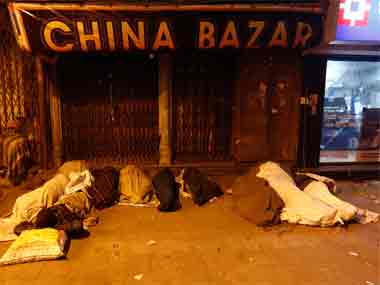Challenging perceptions of homeless living in metros, a new study has claimed that homeless people in Delhi have played an instrumental role in the development of the city. “The general mindset which prevails in the city considers this floating population as a burden on the city’s resources and not as an integral part of the urban landscape or an inevitable consequence of urbanisation. It is important to look at who constitutes this population: they are the rag pickers, rickshaw pullers, construction workers, porters and such others. Their contribution is invaluable in running the city’s business and easing the daily life of its people. It is these hands who have played a key role in developing the infrastructure of Delhi,” says the yet to be released ‘Homeless Survey 2010’ executed by the Delhi government in collaboration with UNDP India. [caption id=“attachment_156919” align=“alignleft” width=“380” caption=“Homeless people sleep on a roadside in old Delhi: Reuters”]  [/caption] The report estimates that more than 67000 homeless people live in Delhi, constituting 0.5 percent of the national capital’s total population. An estimated 69 percent of this number are working and actively contribute to the city’s economy. The report also says that although a sizeable number of homeless are from Delhi, this section of the population is actually made up of people from almost every state and union territory of the country. Other findings from the report are that around 73.1 percent of the population have been living in Delhi for more than five years, and agriculture had been the ancestral occupation of almost half (49.6 percent) of the respondents. “Had the vocation of farming could be made profitable, at least the homeless population of Delhi would have been less by more than 60 percent,” says the report. The study, done between July and December 2010, is the latest profiling of its kind. The data is expected to become a parameter to design welfare schemes for the homeless in Delhi and help the government formulate inclusive policies. The study also reinforced Delhi as an unsafe city for women. Pointing to a disturbing trend, it noted that the ratio of homeless girls sharply falls as they enter puberty and adulthood. “The streets seem to be quite unsafe for homeless girls and women of the reproductive age- group. The reason for the sharp decline in the sex ratio needs to be studied", it said. Eighty five percent of the population are men. The report also said that the homeless were regularly picked up by the police mainly because they take refuge on the pavements, beneath flyovers, and near railway tracks and do not have identity proof. In January 2010, the Supreme Court and the Delhi High Court took suo- motu cognisance of the matter and ordered the state government to formulate short term and long term programs for the homeless. In the wake of the order, the state government undertook a comprehensive survey of the homeless and provided them with provisional identity cards. The homeless people covered by the survey have been enrolled in the national population register or NPR. However 97 percent of the homeless in Delhi did not possess any identity proof at the time of survey.
A new study undertaken by the Delhi government together with the UNDP has shown that homeless people in Delhi have played an instrumental role in the development of the city.
Advertisement
End of Article


)

)
)
)
)
)
)
)
)



